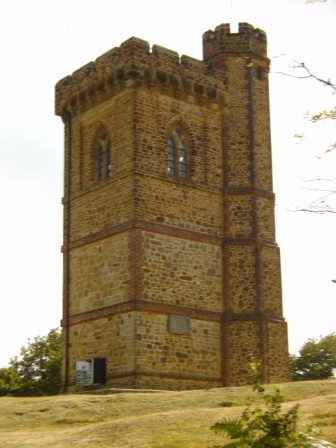
| TP Index | *** | Wood Lane | *** | Leith Hill | *** | Emily | *** | Teleportation | *** | Dinner Photos | *** | Kindred Spirits | *** | Fan Fiction |
 |
Basic Facts | Leith Hill Tower | |
| The Site | Leith Hill | ||
| Concept and Construction | Abinger Road | ||
| Decay and Desolation | Near Dorking | ||
| Restoration and Rebirth | Surrey, UK | ||
| The Tomorrow People | |||
| Leith Hill Place |
| Location | 51:10:30 N, 00:22:14 W, Near Dorking, Surrey, UK (Map) | |
| Original Name | Prospect House | |
| Height of Hill | 965ft (294m) | |
| Height of Tower | 64ft (19.5m) | |
| Date of Construction | 1765 | |
| Commisioned By | Richard Hull of Leith Hill Place | |
| Current Owners | The National Trust |
At 294m (965ft) in height Leith Hill in Surrey is the tallest hill in South Eastern England and is said to be the tallest hill on its latitude until you reach the Ural mountains to the East. On a clear day, 13 counties may be seen from its summit, stretching from the English Channel to central London.
Leith Hill is one of a chain of hills in Surrey which includes Box Hill and Colley Hill and which together form an Area of Outstanding Natural Beauty. It is located one mile south west of Coldharbour and is about five miles from Dorking. For information on how to reach Leith Hill see this link.
Leith Hill is one possible site of one of the battles reported in the Anglo-Saxon Chronicle. Archaeological excavations carried out in 1882 in the nearby Ockley found the remains of large numbers of men, supporting the theory that a large battle took place nearby, and as the most prominant high ground in the region Leith Hill is likely to have played its role in the conflict.
From 'The Anglo Saxon Chronicle' - A.D. 851.
This year Alderman Ceorl, with the men of Devonshire, fought the heathen army at Wemburg, and after making great slaughter obtained the victory. The same year King Athelstan and Alderman Elchere fought in their ships, and slew a large army at Sandwich in Kent, taking nine ships and dispersing the rest. The heathens now for the first time remained over winter in the Isle of Thanet. The same year came three hundred and fifty ships into the mouth of the Thames; the crew of which went upon land, and stormed Canterbury and London; putting to flight Bertulf, king of the Mercians, with his army; and then marched southward over the Thames into Surrey. Here Ethelwulf and his son Ethelbald, at the head of the West-Saxon army, fought with them at Ockley, and made the greatest slaughter of the heathen army that we have ever heard reported to this present day. There also they obtained the victory.
Leith Hill Tower was constructed in 1765, on the orders of Richard Hull. Hull, resident of the nearby Leith Hill Place (see below), who objected to the fact that his local hill was just thirty-five feet short of the magic 1000 feet mark (above which the hill might be considered a mountain). With the permission of the Lord of the Manor he constructed the 'Prospect House' to rectify this problem. With a height of 64 feet, the top of the tower lies 1029 feet above sea level. Prospect towers were popular at the time, built as follies by local landowners to allow maximum enjoyment of particularly spectacular panoramas or high points on their properties.
The tower was constructed in a Gothic style, with two furnished rooms and a 'prospect glass' (or small telescope) mounted on its roof. At that time the tower lacked the octagonal turret that is now attached to one corner of the building. A latin inscription above its doorway announces that Hull built it for the pleasure of others as well as his own.
Richard Hull was buried beneath the floor of the tower upon his death in 1772 and a marble plaque installed in the wall to mark his grave. Believing that the world would be overturned on the day of judgement, and wishing to meet his maker on his feet, it is believed that Hull chose to be buried upside down in his grave. This interpretation of the biblical book of Revelation (presumably the verse quoted below or similar) appears to have been shared by a second local eccentric, Major Peter Laballiere of Box Hill (7 miles from Leith Hill) who was buried in the same manner in 1800.
The Book of Revelations (King James Version) - Ch. 6, v.14
And the heaven departed as a scroll when it is rolled together; and every mountain and island were moved out of their places.
After the death of its creator, the tower fell into a sad state of decay and disrepair. Despite the presence of a tomb in the lower floor, the tower suffered extensively from vandalism and by the early nineteenth century was no longer usable as a prospect tower. In an effort to reduce the amount of vandalism, the tower's roof access was blocked and its two rooms filled with a mixture of rubble and concrete early in the 19th century.
Leith Hill was sketched by T Allom in 1844 as part of Brayley's History of Surrey. Although the tower is not clear in the sketch, it is clear how prominant its position is, and how far the hill extends above the lands around it.
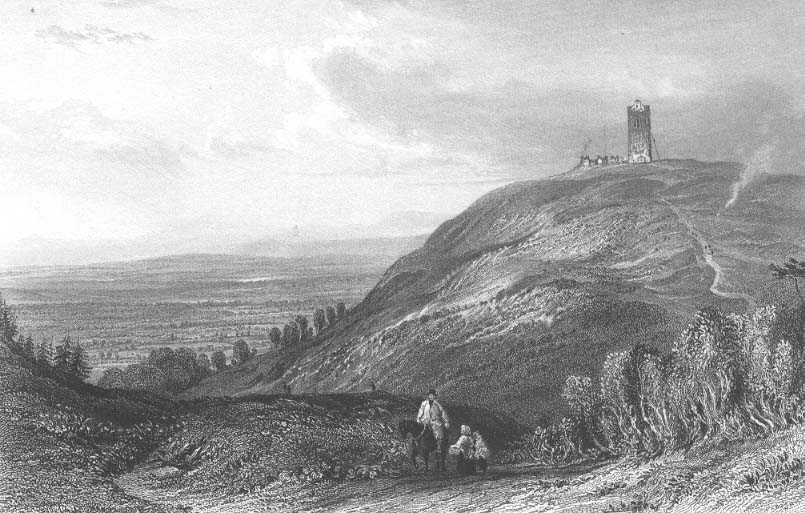 |
A sketch of Leith Hill Surrey, c 1844, from Brayley's History of Surrey |
In 1864 Mr Evelyn of nearby Wotton Hall (whose family owned much of the land on and around Leith Hill) decided to reopen the tower to visitors, but found the concrete and rubble filling an inpenetrable mass. He chose instead to order the construction of the side turret which now forms part of the structure. Its 75 steps ascend directly to the roof of the tower in a spiral staircase.
|
The Tower was given to the National Trust by Mr W J McAndrew in 1923. The new external staircase allowed the continued use of the tower as a viewing platform and in 1929 bronze tablets were placed on the roof pointing out places of interest and commemorating the life of "Walker Miles".
"Walker Miles" was, in fact, a printer named Edmund Taylor. He championed ancient rights of way, rediscovering and publicising them until his death in 1908 (and burial in Godstone, about ten miles away). In 1984 the National Trust embarked on an extensive restoration, removing the rubble and concrete filling the tower's two rooms and uncovering the tomb of Richard Hull. A cafe has been installed in the lower room of the tower which also houses a display on its history. The tower is now open to the public two days a week in the winter months and four days a week in the summer. |
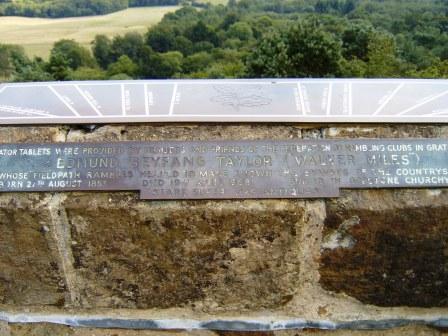
|
In 1978, Leith Hill Tower was used for filming of an episode of the Thames television science fiction series The Tomorrow People. In episode two of the serial 'Castle of Fear', the tower was portrayed as lying on the estate of the Forbes family, on the shores of Loch Ness, Scotland. Only the roof of the tower was shown in any detail, although there were several exterior shots. Viewed in thick fog, no distinguishing features of the tower are clearly visible, although the commemoration plaque for "Walker Miles" is briefly visible in one scene, as is the latin inscription plaque above the door to the tower.
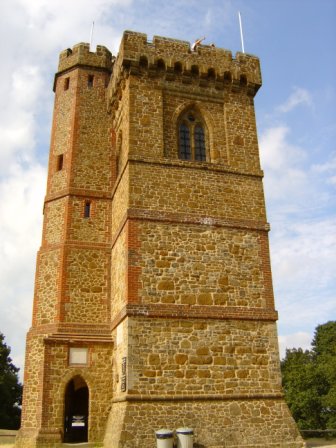 |
The Tower (Exterior View) (Seen on screen in 1978 and in August 2006) |
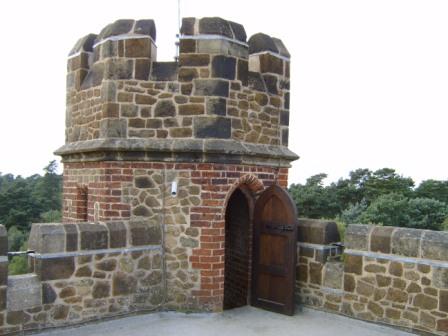 |
The stair turret from the roof (Seen on screen in 1978 and in August 2006) | |
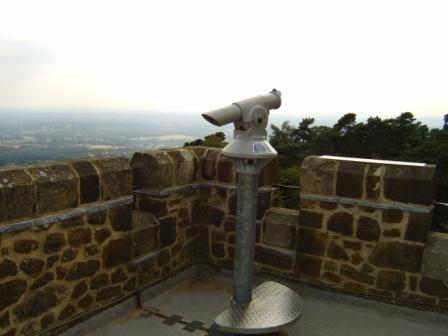 |
The roof of Leith Hill Tower (Seen on screen in 1978 and in August 2006) |
Leith Hill Place is a country house built c.1600 in Tanhurst Lane nearby.
In the second half of the nineteenth century it was owned by the Josiah Wedgwood (grandson of the famous potter and one of the extensive and talented Darwin-Wedgwood family) and his wife, Caroline (who also planted a Rhodedendon wood which still exists on Leith Hill to this day). Her brother, Charles Darwin, spent several holidays there visiting his relatives and conducting his experiments in the rural setting.
The house later passed into the family of Ralph Vaughan Williams (a descendent of the Wedgwood family on his mother's side) and he lived there from the age of 3 until leaving for college. In 1944 he donated the house to the National Trust. He remained in the area though, for many years (from 1905 to 1953) conducting the Leith Hill Music Festival founded by his sister. The Festival is still held annually in Dorking Halls.
The gardens of Leith Hill Place are now open to the public under National Trust ownership.
The Tomorrow People belongs to Fremantle Media and was created by Roger Price. Photos are © Elizabeth Stanway (August 2006)
Comments would be welcome to tiylaya@yahoo.com.
For my other TP related pages click here
This page created by Elizabeth Stanway (January 2005). If you are a confused work colleague you probably want my academic website instead click here.